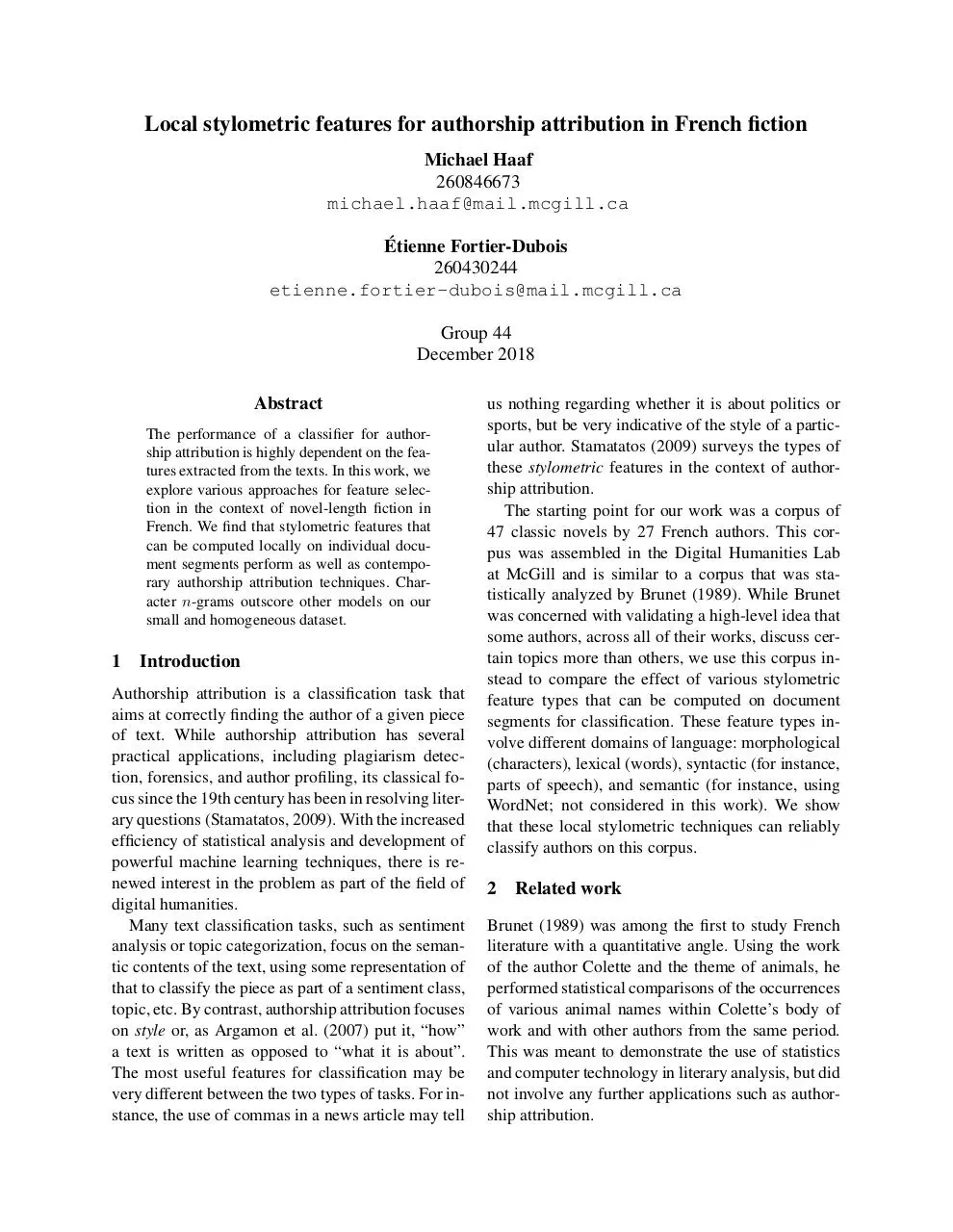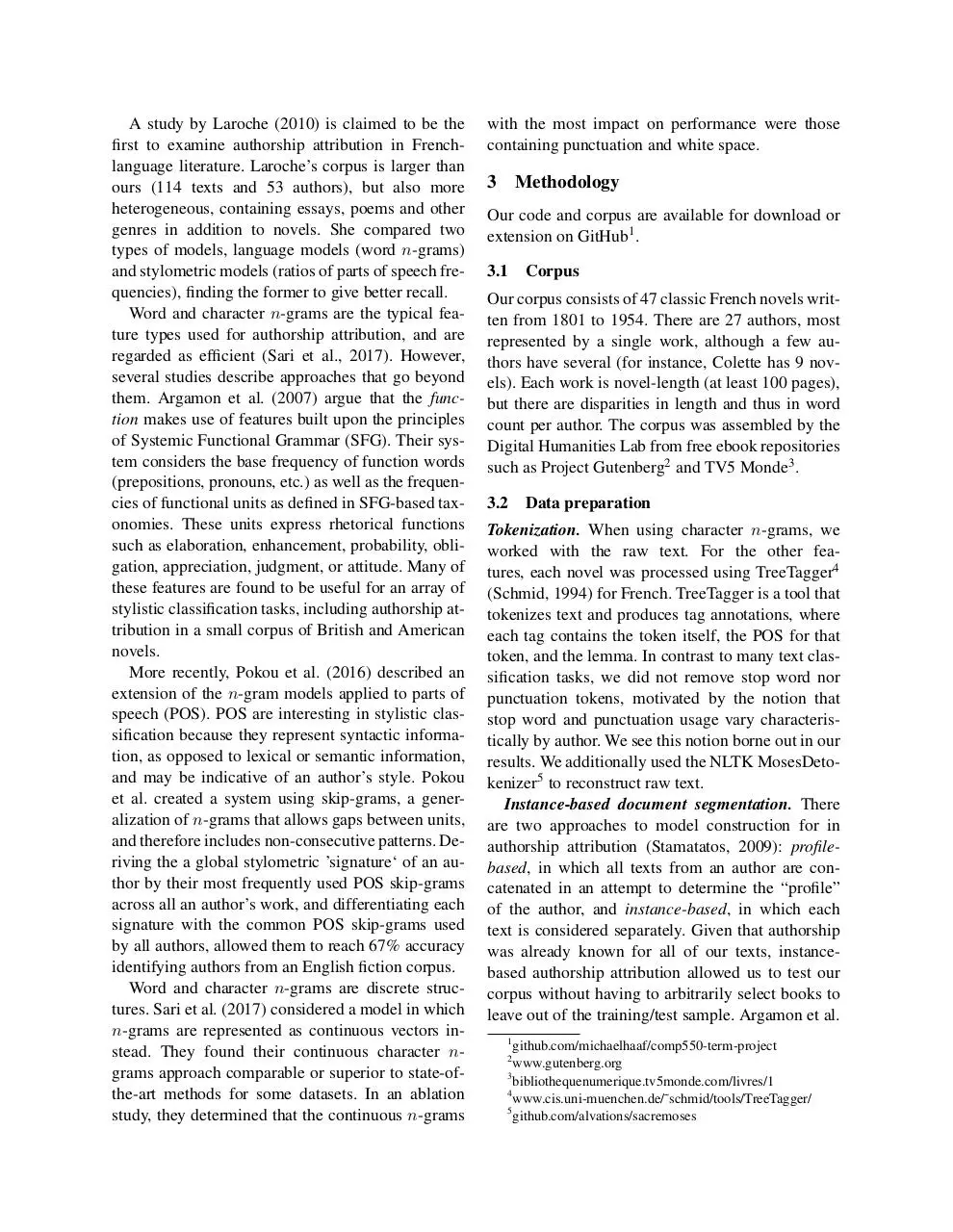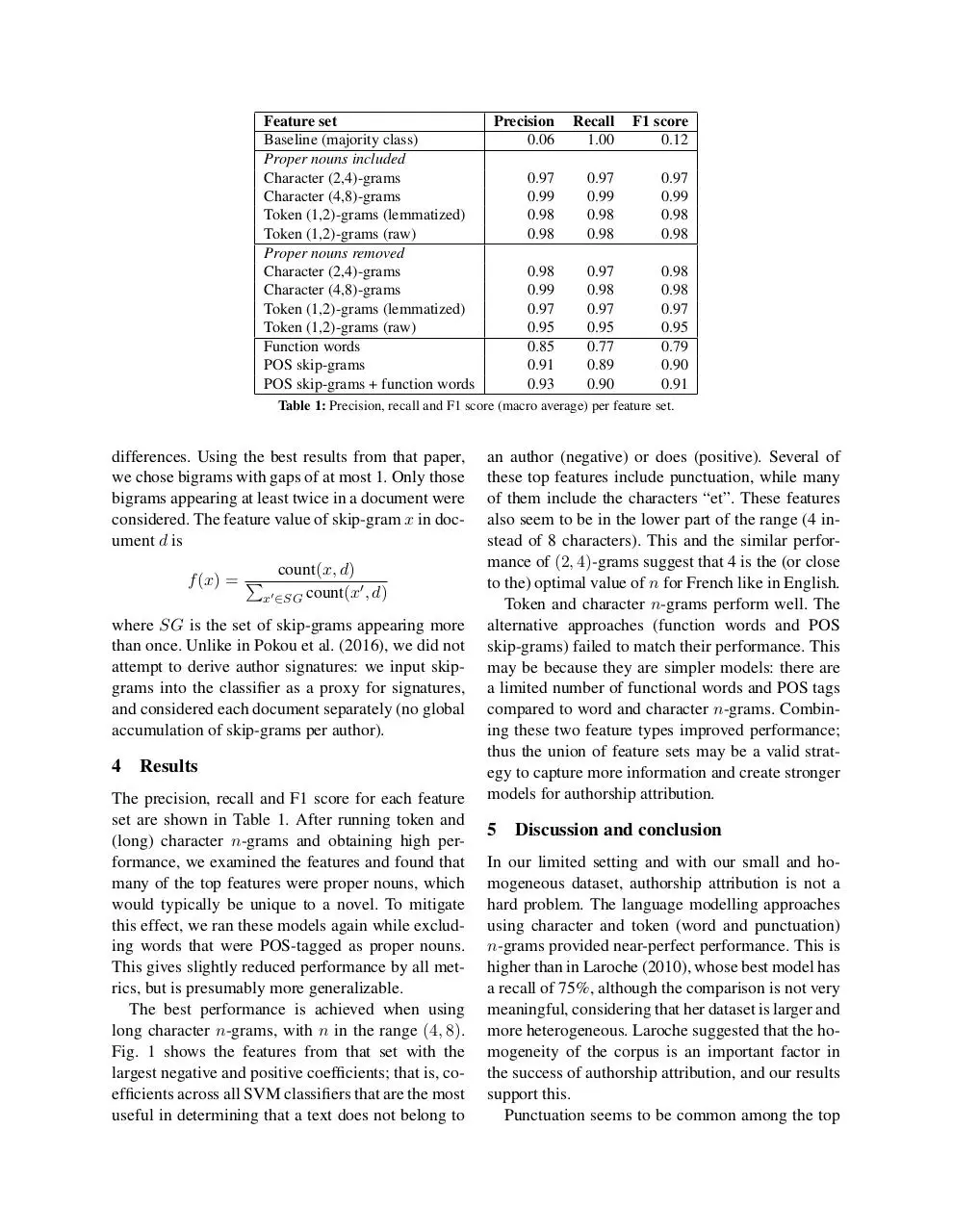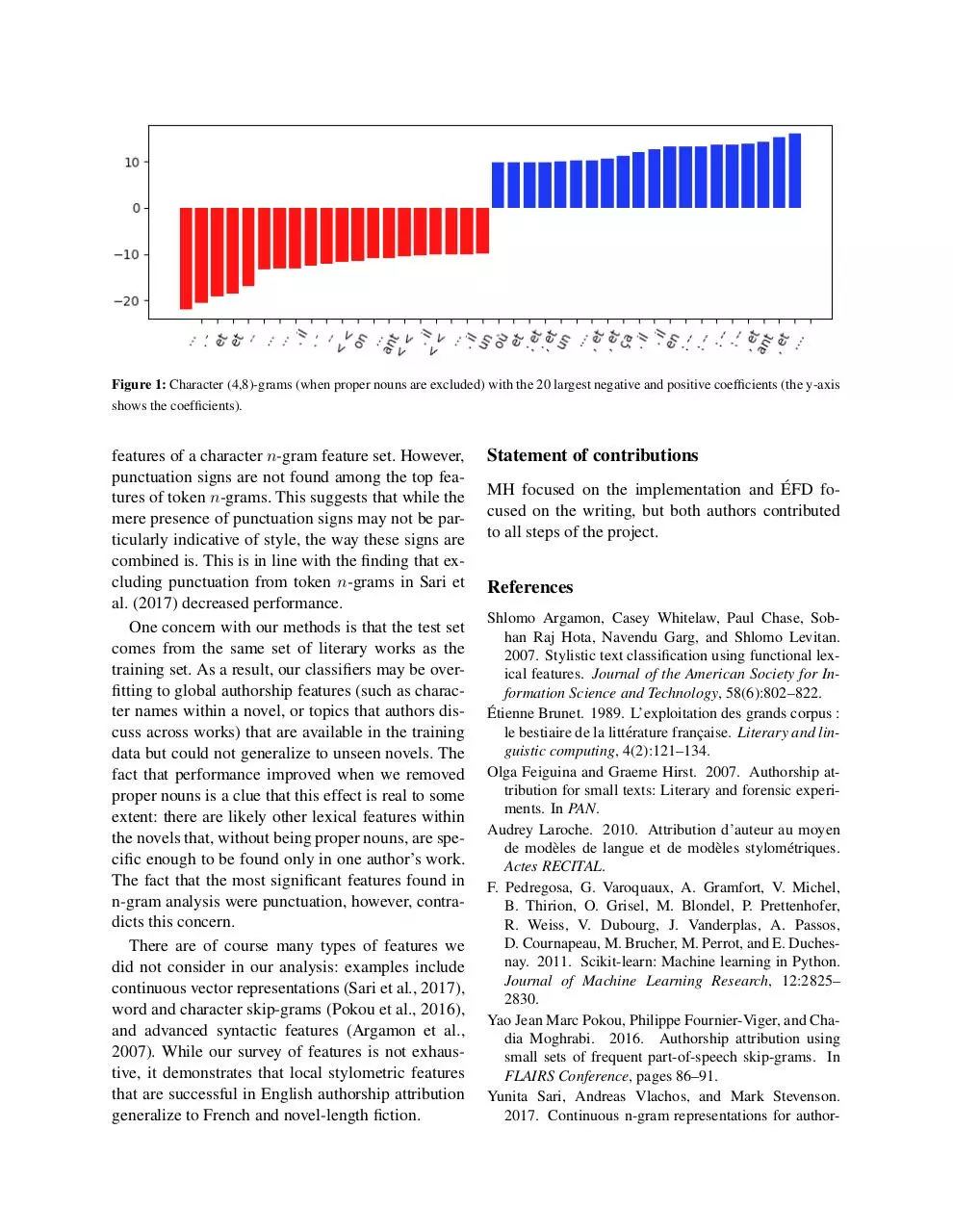Project report (PDF)
File information
This PDF 1.5 document has been generated by TeX / pdfTeX-1.40.17, and has been sent on pdf-archive.com on 03/06/2019 at 15:52, from IP address 69.172.x.x.
The current document download page has been viewed 393 times.
File size: 156.68 KB (6 pages).
Privacy: public file





File preview
Local stylometric features for authorship attribution in French fiction
Michael Haaf
260846673
michael.haaf@mail.mcgill.ca
´
Etienne
Fortier-Dubois
260430244
etienne.fortier-dubois@mail.mcgill.ca
Group 44
December 2018
Abstract
The performance of a classifier for authorship attribution is highly dependent on the features extracted from the texts. In this work, we
explore various approaches for feature selection in the context of novel-length fiction in
French. We find that stylometric features that
can be computed locally on individual document segments perform as well as contemporary authorship attribution techniques. Character n-grams outscore other models on our
small and homogeneous dataset.
1
Introduction
Authorship attribution is a classification task that
aims at correctly finding the author of a given piece
of text. While authorship attribution has several
practical applications, including plagiarism detection, forensics, and author profiling, its classical focus since the 19th century has been in resolving literary questions (Stamatatos, 2009). With the increased
efficiency of statistical analysis and development of
powerful machine learning techniques, there is renewed interest in the problem as part of the field of
digital humanities.
Many text classification tasks, such as sentiment
analysis or topic categorization, focus on the semantic contents of the text, using some representation of
that to classify the piece as part of a sentiment class,
topic, etc. By contrast, authorship attribution focuses
on style or, as Argamon et al. (2007) put it, “how”
a text is written as opposed to “what it is about”.
The most useful features for classification may be
very different between the two types of tasks. For instance, the use of commas in a news article may tell
us nothing regarding whether it is about politics or
sports, but be very indicative of the style of a particular author. Stamatatos (2009) surveys the types of
these stylometric features in the context of authorship attribution.
The starting point for our work was a corpus of
47 classic novels by 27 French authors. This corpus was assembled in the Digital Humanities Lab
at McGill and is similar to a corpus that was statistically analyzed by Brunet (1989). While Brunet
was concerned with validating a high-level idea that
some authors, across all of their works, discuss certain topics more than others, we use this corpus instead to compare the effect of various stylometric
feature types that can be computed on document
segments for classification. These feature types involve different domains of language: morphological
(characters), lexical (words), syntactic (for instance,
parts of speech), and semantic (for instance, using
WordNet; not considered in this work). We show
that these local stylometric techniques can reliably
classify authors on this corpus.
2
Related work
Brunet (1989) was among the first to study French
literature with a quantitative angle. Using the work
of the author Colette and the theme of animals, he
performed statistical comparisons of the occurrences
of various animal names within Colette’s body of
work and with other authors from the same period.
This was meant to demonstrate the use of statistics
and computer technology in literary analysis, but did
not involve any further applications such as authorship attribution.
A study by Laroche (2010) is claimed to be the
first to examine authorship attribution in Frenchlanguage literature. Laroche’s corpus is larger than
ours (114 texts and 53 authors), but also more
heterogeneous, containing essays, poems and other
genres in addition to novels. She compared two
types of models, language models (word n-grams)
and stylometric models (ratios of parts of speech frequencies), finding the former to give better recall.
Word and character n-grams are the typical feature types used for authorship attribution, and are
regarded as efficient (Sari et al., 2017). However,
several studies describe approaches that go beyond
them. Argamon et al. (2007) argue that the function makes use of features built upon the principles
of Systemic Functional Grammar (SFG). Their system considers the base frequency of function words
(prepositions, pronouns, etc.) as well as the frequencies of functional units as defined in SFG-based taxonomies. These units express rhetorical functions
such as elaboration, enhancement, probability, obligation, appreciation, judgment, or attitude. Many of
these features are found to be useful for an array of
stylistic classification tasks, including authorship attribution in a small corpus of British and American
novels.
More recently, Pokou et al. (2016) described an
extension of the n-gram models applied to parts of
speech (POS). POS are interesting in stylistic classification because they represent syntactic information, as opposed to lexical or semantic information,
and may be indicative of an author’s style. Pokou
et al. created a system using skip-grams, a generalization of n-grams that allows gaps between units,
and therefore includes non-consecutive patterns. Deriving the a global stylometric ’signature‘ of an author by their most frequently used POS skip-grams
across all an author’s work, and differentiating each
signature with the common POS skip-grams used
by all authors, allowed them to reach 67% accuracy
identifying authors from an English fiction corpus.
Word and character n-grams are discrete structures. Sari et al. (2017) considered a model in which
n-grams are represented as continuous vectors instead. They found their continuous character ngrams approach comparable or superior to state-ofthe-art methods for some datasets. In an ablation
study, they determined that the continuous n-grams
with the most impact on performance were those
containing punctuation and white space.
3
Methodology
Our code and corpus are available for download or
extension on GitHub1 .
3.1
Corpus
Our corpus consists of 47 classic French novels written from 1801 to 1954. There are 27 authors, most
represented by a single work, although a few authors have several (for instance, Colette has 9 novels). Each work is novel-length (at least 100 pages),
but there are disparities in length and thus in word
count per author. The corpus was assembled by the
Digital Humanities Lab from free ebook repositories
such as Project Gutenberg2 and TV5 Monde3 .
3.2
Data preparation
Tokenization. When using character n-grams, we
worked with the raw text. For the other features, each novel was processed using TreeTagger4
(Schmid, 1994) for French. TreeTagger is a tool that
tokenizes text and produces tag annotations, where
each tag contains the token itself, the POS for that
token, and the lemma. In contrast to many text classification tasks, we did not remove stop word nor
punctuation tokens, motivated by the notion that
stop word and punctuation usage vary characteristically by author. We see this notion borne out in our
results. We additionally used the NLTK MosesDetokenizer5 to reconstruct raw text.
Instance-based document segmentation. There
are two approaches to model construction for in
authorship attribution (Stamatatos, 2009): profilebased, in which all texts from an author are concatenated in an attempt to determine the “profile”
of the author, and instance-based, in which each
text is considered separately. Given that authorship
was already known for all of our texts, instancebased authorship attribution allowed us to test our
corpus without having to arbitrarily select books to
leave out of the training/test sample. Argamon et al.
1
github.com/michaelhaaf/comp550-term-project
www.gutenberg.org
3
bibliothequenumerique.tv5monde.com/livres/1
4
www.cis.uni-muenchen.de/˜schmid/tools/TreeTagger/
5
github.com/alvations/sacremoses
2
(2007) took a similar approach by manually splitting all novels into chapters, motivated by the cohesion and independent discourse properties of novel
chapters. Manually segmenting novels by chapters is
tedious work requiring human expertise; we sought
to automate a similar process by segmenting each
novel into 1000-token “documents”. While there is
no consensus on document size for automated segmentation (Stamatatos, 2009) Feiguina and Hirst
(2007) conclude that instance-based classification
accuracy decreases at segments with less than 1000
tokens. We independently verified this heuristic.
Balancing the corpus. Since authors do not produce uniform amounts of text, and not all texts produced are publicly available, it is common in author attribution problems to have unbalanced corpora. The ‘true’ distribution of authors on unknown
data, however, is not proportional to the distribution of authors on known data. Stamatatos (2009)
argues that, in training/test data splits, the test data
set should be balanced; that is, uniformly distributed
across authors. In our experiments, we ensured that
all authors had just 20 randomly selected documents
(corresponding to 20,000 tokens) available for each
in the test set (using a standard training/test split of
80/20). Any authors with less than this amount of
data were excluded from analysis. This resulted in a
test set of 16 authors and 320 documents. We verified the intuition that balancing the test data does
improve the performance of classifiers for authors
less represented in the corpus.
3.3
Classifier and evaluation
For each of several feature sets, we classified documents using support vector machines (SVM) with
stochastic gradient descent, implemented in the
scikit-learn library (Pedregosa et al., 2011) under the
name SGDClassifier. Since our balanced corpus gives a multilabel classification problem with
16 authors, we trained 16 different SVM classifiers (one per author) each employing the one-vsrest strategy. We performed 5-fold cross-validation
to tune the hyperparameters alpha (over values
{0.00001, 0.000001}) and max iter (over values
{10, 50, 80}). We used the F1 score to evaluate the
performance of the model for each feature set.
Given that many of our feature sets produce a
large number of features, and given that stylome-
try in author attribution is a problem with linguistic interest, we forced our classifier to use L1-norm
regularization. L1-norm regularization emphasizes
highly performant features while zeroing out inconsequential features. In doing so, we produced feature sets that are easier to comprehend, emphasizing
a relatively smaller number of features.
3.4
Feature sets
Character n-grams. Character n-grams are all sequences of n characters found in a text. They are
considered useful in stylistic classification (Stamatatos, 2009; Sari et al., 2017) in part because they
are resistant to spelling variations, which can be indicative of author style. According to Stamatatos
(2009), the best value of n varies by language and is
dependent on typical word length; n = 4 is considered optimal for English. Since French has generally
similar word lengths to English, we tried two models
both including n = 4: a short n-gram model has n
in the range of (2, 4), and a long n-gram model has
n in the range (4, 8).
Token n-grams. Word n-grams are the classical
feature type for text classification and can be useful
in identifying and distinguishing characteristic author word choice. We considered all tokens (words
and punctuation) and used n values in the range of
(1, 2). We tried this for both lemmatized and raw
versions of the input.
Function words. Function words are words that
express grammatical relationships or attitudes rather
than lexical meaning. They can be effective in stylistic classification (Argamon et al., 2007). As Stamatatos (2009) notes, “the selection of the specific function words that will be used as features is usually based on arbitrary criteria and requires language-dependent expertise.” We identified
as function words those that were POS-tagged as determiners, interjections, conjunctions, prepositions,
and pronouns. The feature value of a function word
w in a document d is
count(w, d)
0
w0 ∈F W count(w , d)
f (w) = P
where F W is the set of all function words (Argamon
et al., 2007).
POS skip-grams. We implemented the POS skipgram approach from Pokou et al. (2016) with some
Feature set
Baseline (majority class)
Proper nouns included
Character (2,4)-grams
Character (4,8)-grams
Token (1,2)-grams (lemmatized)
Token (1,2)-grams (raw)
Proper nouns removed
Character (2,4)-grams
Character (4,8)-grams
Token (1,2)-grams (lemmatized)
Token (1,2)-grams (raw)
Function words
POS skip-grams
POS skip-grams + function words
Precision
0.06
Recall
1.00
F1 score
0.12
0.97
0.99
0.98
0.98
0.97
0.99
0.98
0.98
0.97
0.99
0.98
0.98
0.98
0.99
0.97
0.95
0.85
0.91
0.93
0.97
0.98
0.97
0.95
0.77
0.89
0.90
0.98
0.98
0.97
0.95
0.79
0.90
0.91
Table 1: Precision, recall and F1 score (macro average) per feature set.
differences. Using the best results from that paper,
we chose bigrams with gaps of at most 1. Only those
bigrams appearing at least twice in a document were
considered. The feature value of skip-gram x in document d is
count(x, d)
0
x0 ∈SG count(x , d)
f (x) = P
where SG is the set of skip-grams appearing more
than once. Unlike in Pokou et al. (2016), we did not
attempt to derive author signatures: we input skipgrams into the classifier as a proxy for signatures,
and considered each document separately (no global
accumulation of skip-grams per author).
4
Results
The precision, recall and F1 score for each feature
set are shown in Table 1. After running token and
(long) character n-grams and obtaining high performance, we examined the features and found that
many of the top features were proper nouns, which
would typically be unique to a novel. To mitigate
this effect, we ran these models again while excluding words that were POS-tagged as proper nouns.
This gives slightly reduced performance by all metrics, but is presumably more generalizable.
The best performance is achieved when using
long character n-grams, with n in the range (4, 8).
Fig. 1 shows the features from that set with the
largest negative and positive coefficients; that is, coefficients across all SVM classifiers that are the most
useful in determining that a text does not belong to
an author (negative) or does (positive). Several of
these top features include punctuation, while many
of them include the characters “et”. These features
also seem to be in the lower part of the range (4 instead of 8 characters). This and the similar performance of (2, 4)-grams suggest that 4 is the (or close
to the) optimal value of n for French like in English.
Token and character n-grams perform well. The
alternative approaches (function words and POS
skip-grams) failed to match their performance. This
may be because they are simpler models: there are
a limited number of functional words and POS tags
compared to word and character n-grams. Combining these two feature types improved performance;
thus the union of feature sets may be a valid strategy to capture more information and create stronger
models for authorship attribution.
5
Discussion and conclusion
In our limited setting and with our small and homogeneous dataset, authorship attribution is not a
hard problem. The language modelling approaches
using character and token (word and punctuation)
n-grams provided near-perfect performance. This is
higher than in Laroche (2010), whose best model has
a recall of 75%, although the comparison is not very
meaningful, considering that her dataset is larger and
more heterogeneous. Laroche suggested that the homogeneity of the corpus is an important factor in
the success of authorship attribution, and our results
support this.
Punctuation seems to be common among the top
Figure 1: Character (4,8)-grams (when proper nouns are excluded) with the 20 largest negative and positive coefficients (the y-axis
shows the coefficients).
features of a character n-gram feature set. However,
punctuation signs are not found among the top features of token n-grams. This suggests that while the
mere presence of punctuation signs may not be particularly indicative of style, the way these signs are
combined is. This is in line with the finding that excluding punctuation from token n-grams in Sari et
al. (2017) decreased performance.
One concern with our methods is that the test set
comes from the same set of literary works as the
training set. As a result, our classifiers may be overfitting to global authorship features (such as character names within a novel, or topics that authors discuss across works) that are available in the training
data but could not generalize to unseen novels. The
fact that performance improved when we removed
proper nouns is a clue that this effect is real to some
extent: there are likely other lexical features within
the novels that, without being proper nouns, are specific enough to be found only in one author’s work.
The fact that the most significant features found in
n-gram analysis were punctuation, however, contradicts this concern.
There are of course many types of features we
did not consider in our analysis: examples include
continuous vector representations (Sari et al., 2017),
word and character skip-grams (Pokou et al., 2016),
and advanced syntactic features (Argamon et al.,
2007). While our survey of features is not exhaustive, it demonstrates that local stylometric features
that are successful in English authorship attribution
generalize to French and novel-length fiction.
Statement of contributions
´
MH focused on the implementation and EFD
focused on the writing, but both authors contributed
to all steps of the project.
References
Shlomo Argamon, Casey Whitelaw, Paul Chase, Sobhan Raj Hota, Navendu Garg, and Shlomo Levitan.
2007. Stylistic text classification using functional lexical features. Journal of the American Society for Information Science and Technology, 58(6):802–822.
´
Etienne
Brunet. 1989. L’exploitation des grands corpus :
le bestiaire de la litt´erature franc¸aise. Literary and linguistic computing, 4(2):121–134.
Olga Feiguina and Graeme Hirst. 2007. Authorship attribution for small texts: Literary and forensic experiments. In PAN.
Audrey Laroche. 2010. Attribution d’auteur au moyen
de mod`eles de langue et de mod`eles stylom´etriques.
Actes RECITAL.
F. Pedregosa, G. Varoquaux, A. Gramfort, V. Michel,
B. Thirion, O. Grisel, M. Blondel, P. Prettenhofer,
R. Weiss, V. Dubourg, J. Vanderplas, A. Passos,
D. Cournapeau, M. Brucher, M. Perrot, and E. Duchesnay. 2011. Scikit-learn: Machine learning in Python.
Journal of Machine Learning Research, 12:2825–
2830.
Yao Jean Marc Pokou, Philippe Fournier-Viger, and Chadia Moghrabi. 2016. Authorship attribution using
small sets of frequent part-of-speech skip-grams. In
FLAIRS Conference, pages 86–91.
Yunita Sari, Andreas Vlachos, and Mark Stevenson.
2017. Continuous n-gram representations for author-
ship attribution. In Proceedings of the 15th Conference of the European Chapter of the Association for
Computational Linguistics: Volume 2, Short Papers,
volume 2, pages 267–273.
Helmut Schmid. 1994. Probabilistic part-of-speech tagging using decision trees. International Confernce on
New Methods in Language Processing.
Efstathios Stamatatos. 2009. A survey of modern authorship attribution methods. Journal of the American Society for information Science and Technology,
60(3):538–556.
Download Project report
Project report.pdf (PDF, 156.68 KB)
Download PDF
Share this file on social networks
Link to this page
Permanent link
Use the permanent link to the download page to share your document on Facebook, Twitter, LinkedIn, or directly with a contact by e-Mail, Messenger, Whatsapp, Line..
Short link
Use the short link to share your document on Twitter or by text message (SMS)
HTML Code
Copy the following HTML code to share your document on a Website or Blog
QR Code to this page

This file has been shared publicly by a user of PDF Archive.
Document ID: 0001931306.